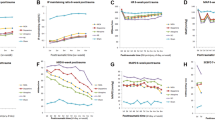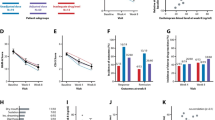Abstract
Study design:
Single centre, single ascending dose study.
Objectives:
To compare the pharmacokinetics and assess the safety of capromorelin, a compound that has potential to treat constipation following spinal cord injury (SCI), in groups of able-bodied and SCI volunteers.
Setting:
Local population from Victoria, Australia.
Methods:
Following initial screening and baseline blood collections, participants received ascending oral doses (20, 50 and then 100 mg at least 1-week apart) of capromorelin after pre-dose blood collection, followed by blood collections over the following 12 h for pharmacokinetic analysis and 1-week and 4-week follow-up blood collections for safety evaluations. Blood pressure and heart rate were monitored.
Results:
No serious adverse events were recorded following any dose in either the able-bodied group or the SCI group. There were no abnormal blood pressure or heart rate changes. Minor adverse events resolved quickly without the need for treatment. Pharmacokinetic behaviour was broadly similar between groups, with both exhibiting dose-dependent increases in Cmax and AUC0–∞. The SCI participants showed greater variance in pharmacokinetic parameters and had a slightly delayed Tmax and half-life.
Conclusion:
Capromorelin at the doses tested was safe and well tolerated in both SCI and able-bodied participants and also showed similar pharmacokinetics with dose-dependent increases in concentration and drug exposure.
Sponsorship:
Support for the study was provided by the Victorian State Government Transport Accident Commission.
Similar content being viewed by others
Log in or create a free account to read this content
Gain free access to this article, as well as selected content from this journal and more on nature.com
or
References
Coggrave MJ, Norton C . The need for manual evacuation and oral laxatives in the management of neurogenic bowel dysfunction after spinal cord injury: a randomized controlled trial of a stepwise protocol. Spinal Cord 2010; 48: 504–510.
Widerstrom-Noga EG, Felipe-Cuervo E, Broton JG, Duncan RC, Yezierski RP . Perceived difficulty in dealing with consequences of spinal cord injury. Arch Phys Med Rehabil 1999; 80: 580–586.
Korsten MA, Rosman AS, Ng A, Cavusoglu E, Spungen AM, Radulovic M et al. Infusion of neostigmine-glycopyrrolate for bowel evacuation in persons with spinal cord injury. Am J Gastroenterol 2005; 100: 1560–1565.
Rosman AS, Chaparala G, Monga A, Spungen AM, Bauman WA, Korsten MA . Intramuscular neostigmine and glycopyrrolate safely accelerated bowel evacuation in patients with spinal cord injury and defecatory disorders. Dig Dis Sci 2008; 53: 2710–2713.
Krogh K, Jensen MB, Gandrup P, Laurberg S, Nilsson J, Kerstens R et al. Efficacy and tolerability of prucalopride in patients with constipation due to spinal cord injury. Scand J Gastroenterol 2002; 37: 431–436.
Shimizu Y, Chang EC, Shafton AD, Ferens DM, Sanger GJ, Witherington J et al. Evidence that stimulation of ghrelin receptors in the spinal cord initiates propulsive activity in the colon of the rat. J Physiol 2006; 576: 329–338.
Pustovit RV, Callaghan B, Kosari S, Rivera LR, Thomas H, Brock JA et al. The mechanism of enhanced defecation caused by the ghrelin receptor agonist, ulimorelin. Neurogastroenterol Motil 2014; 26: 264–271.
Ferens DM, Habgood MD, Saunders NR, Tan YH, Brown DJ, Brock JA et al. Stimulation of defecation in spinal cord-injured rats by a centrally acting ghrelin receptor agonist. Spinal Cord 2011; 49: 1036–1041.
White HK, Petrie CD, Landschulz W, MacLean D, Taylor A, Lyles K et al. Effects of an oral growth hormone secretagogue in older adults. J Clin Endocrinol Metab 2009; 94: 1198–1206.
Hersch EC, Merriam GR . Growth hormone (GH)-releasing hormone and GH secretagogues in normal aging: Fountain of Youth or Pool of Tantalus? Clin Interv Aging 2008; 3: 121–129.
Agrawal A, Gale JD, Sharma N, Blonski W, Hargreaves K, Allan R et al. Effect of single doses of capromorelin and ghrelin on esophageal reflux parameters and esophageal function: a randomized, double-blind, placebo-controlled study. Gasteroenterology 2009; 136: A120–A121.
Segal JL, Brunnemann SR . Clinical pharmacokinetics in patients with spinal cord injuries. Clin Pharmacokinet 1989; 17: 109–129.
Acknowledgements
The authors gratefully acknowledge the Victorian State Government Transport Accident Commission, through the Institute for Safety, Compensation and Recovery Research, for funding the study, all participants including relatives and caregivers of SCI participants for their cooperation, SCI research coordinator Janette Alexander for assistance in participant screening, Jonathon Baell from the Walter and Eliza Hall Institute Division of Medicinal Chemistry for synthesis of deuterated capromorelin and staff of the Nucleus Network Clinical Trials Unit, Austin Health. Dr Shinichi Koizumi of Raqualia Pharma Inc. kindly provided in-house data from previous trials of capromorelin in human subjects.
Author information
Authors and Affiliations
Corresponding author
Ethics declarations
Competing interests
The authors declare no conflict of interest.
Rights and permissions
About this article
Cite this article
Ellis, A., Zeglinski, P., Brown, D. et al. Pharmacokinetics of the ghrelin agonist capromorelin in a single ascending dose Phase-I safety trial in spinal cord-injured and able-bodied volunteers. Spinal Cord 53, 103–108 (2015). https://doi.org/10.1038/sc.2014.218
Received:
Accepted:
Published:
Issue date:
DOI: https://doi.org/10.1038/sc.2014.218
This article is cited by
-
Neural pathways for colorectal control, relevance to spinal cord injury and treatment: a narrative review
Spinal Cord (2018)
-
Ghrelin and motilin receptors as drug targets for gastrointestinal disorders
Nature Reviews Gastroenterology & Hepatology (2016)



